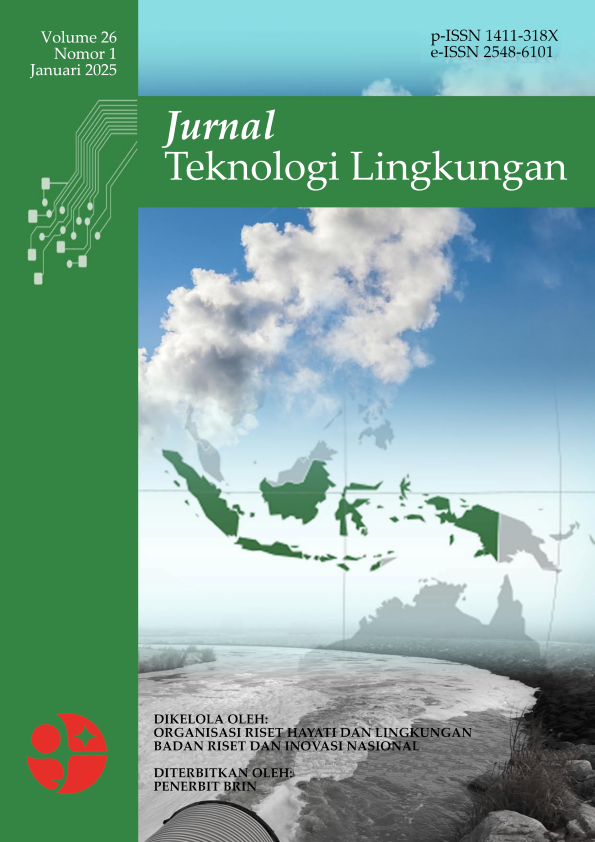Pengaruh Waktu Kontak dan Luas Permukaan Elektroda pada Pengolahan Limbah Cair Pabrik Kelapa Sawit Menggunakan Metode EAPR (Electro-assisted Phytoremediation) dengan Tanaman Eceng Gondok (Eichhornia crassipes)
Main Article Content
Abstract
ABSTRACT
POME wastewater treatment remains a significant area of research due to the industry’s large scale and high potential for wastewater pollution. This research investigated the effect of variations in contact time and surface area of Zinc (Zn) electrodes on the parameters of pH, COD, BOD, TSS, VSS, and oil and fat values in the POME wastewater. POME wastewater treatment was conducted using the EAPR method with an electric voltage of 9 (nine) volts and utilizing 3 (three) water hyacinth plants, each with 5–8 leaves. The treatment process was terminated once the reduction in pollutant concentration reached a constant number. The results showed that the values that met quality standards were pH values in all treatments and BOD values in the 45-minute contact time variation across all electrode surface areas. As for the other analysis values, they did not meet the quality standards, with the highest COD reduction of 91.46%, the highest TSS reduction of 96.77%, the highest VSS reduction of 24.92%, and the highest oil and fat reduction of 98.89% observed in the 75 minutes contact time variation using a cathode surface area of 500 cm2 and anode 14 cm2. It can be concluded that this method is currently ineffective for POME wastewater treatment as not all parameters meet quality standards. This research is expected to provide valuable insights for future experiments in wastewater treatment. Recommendations for further research include adding a method to increase oxygen levels in wastewater or adding microorganisms to enhance organic breakdown.
ABSTRAK
Penelitian mengenai pengolahan limbah cair industri minyak kelapa sawit terus dilakukan karena industri ini merupakan industri yang besar dan menghasilkan banyak limbah cair dengan potensi pencemaran yang tinggi. Penelitian ini bertujuan untuk menganalisis pengaruh waktu kontak dan luas permukaan elektroda seng (Zn) terhadap konsentrasi nilai pH, COD, BOD, TSS, VSS, serta minyak dan lemak. Pengolahan limbah cair pabrik kelapa sawit dilakukan dengan menggunakan metode EAPR bertegangan 9 volt dengan 3 tanaman eceng gondok berdaun 5–8 helai. Perlakuan dihentikan jika penurunan sudah mencapai angka yang konstan. Hasil penelitian menunjukkan bahwa nilai yang memenuhi baku mutu yaitu nilai pH pada seluruh perlakuan dan nilai BOD pada variasi waktu kontak 45 menit di seluruh variasi luas area permukaan elektroda. Sedangkan untuk nilai analisis yang lain masih belum sesuai dengan baku mutu, dengan penurunan COD tertinggi sebesar 91,46%, penurunan TSS tertinggi sebesar 96,77%, penurunan VSS tertinggi sebesar 24,92%, serta penurunan minyak dan lemak tertinggi sebesar 98,89% pada variasi waktu kontak 75 menit dengan luas permukaan katoda 500 cm2 dan anoda 14 cm2. Dapat disimpulkan bahwa metode ini belum efektif untuk pengolahan limbah cair pabrik kelapa sawit karena belum seluruh analisis memenuhi baku mutu. Penelitian ini diharapkan dapat bermanfaat untuk dikaji lebih lanjut untuk pengolahan limbah cair. Saran untuk penelitian selanjutnya yaitu menambahkan metode aerasi supaya dapat meningkatkan kandungan oksigen dalam air limbah atau menambahkan mikroorganisme untuk mengurai kandungan organik.
Article Details

This work is licensed under a Creative Commons Attribution-ShareAlike 4.0 International License.

